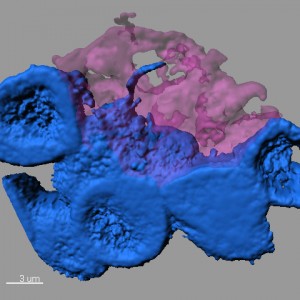Discovery of Nanotubes that Mediate Stem Cell Signaling


Stem cells (blue), cluster around a hub in the stem cell niche (pink). One stem cell extends a nanotube into the hub. Image: Mayu Inaba
A new kind of microtubule-based nanotubes has been discovered by scientists at the University of Michigan Life Sciences Institute and the University of Texas Southwestern Medical Center. The nanotubes communicate stem cells with their niche, and are thought to play a role in limiting the stem cell renewal signals to one of the two cells that result from a cell division. In this way, stem cell division can yield a new stem cell and a differentiated cell. The findings have been published in Nature.
The experiments were carried out in male fruitfly germline stem cells. These cells are surrounded by the niche, a supportive environment that also sends stem cells self-renewing signals. One unanswered question was how the niche could direct the correct signals with spatiotemporal accuracy, so that from a stem cell division one daughter cell kept its stem cell properties and the second one developed into a germ cell. The answer could come from the structures that Yukiko Yamashita’s team noticed: tiny threads connecting some cells to a central hub in the niche. Cells connected to the central hub stayed as stem cells. When the nanotubes where disrupted, those cells lost the ability to stay as stem cells.
Hints of nanotubes have been seen also in mamalian species. This short-range communication between cells could be more common that previously thought. This could be an effective alternative to open signaling pathways, with high specificity in the delivery of messages.
Source:
